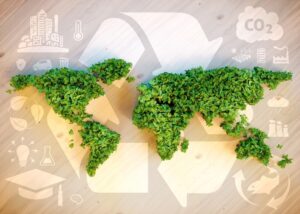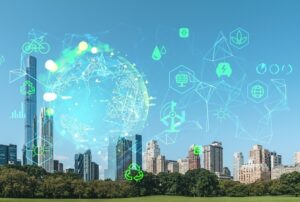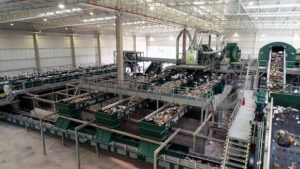Renewable Energy is a form of energy that aims to protect natural resources, impacting as little as possible or mitigating the impact that has already happened. Some sources of Renewable Energy act by taking advantage of the resource’s resilience, that is to say, its ability to recover itself in a short period of time, such as the sun, wind, rain and tides, which quickly reintegrate. Other sources act by reducing the environmental impact of a process that has already taken place, such as the production of garbage, for example.
In general, Renewable Energy allows the recovery of the resource to be seen in the human lifetime scale, unlike non-Renewable Energy such as fossil fuels, for example, which take millions of years to form.
Did you know that Renewable Energy is present in people’s daily lives and often goes unnoticed? A good example for this is garbage, which is produced every day. It also has potential for exploring Renewable Energy, especially when there is separation, collection, disposal and proper treatment.
When thinking about Renewable Energy, it is a cleaner energy production alternative, therefore prioritizing the use of Renewable Energy sources significantly reduces the environmental impacts of one of the activities that most contribute to Global Warming.
The United Nations (UN) has formed a group of scientists dedicated to monitoring and advising all global science related to climate change called the Intergovernmental Panel on Climate Change (IPCC); according to the latest IPCC report, AR6, the planet will increase its temperature by at least 1.5°, and could reach up to 5.7° over the next decade. In practice, this would mean that the sea level will rise and a good part of the coast will be swallowed by the waters, in addition to the impact on agricultural production due to the change in periods of rain and drought and the extinction of the most sensitive animal and plant species in the coastal areas, as well as other indirectly affected areas.
In the world, 85.6% of Energy still comes from non-renewable sources, and the vast majority corresponds to Coal, Oil and Natural Gas, while the portion that represents Renewable Energy sources corresponds to only 14.1% of the energy produced in the world.
RENEWABLE ENERGY IN BRAZIL
Brazil has enormous potential for harnessing renewable energy sources. In addition to being a country of continental dimensions and being the second largest in forest areas in the world, there is an enormous availability of rivers, a reasonable wind regime, especially in the Northeastern region and, as it is located in the equatorial region, it also receives a large quantity of sunlight; this makes the country perfect for achieving a 100% Renewable energy matrix, taking advantage of its natural condition and exploring new sources of Energy such as Biogas, for example.
Comparatively, Brazil has a more renewable energy matrix than the world matrix, with 55.3% corresponding to its renewable energy production, while the world average is around 14.1% according to the National Energy Balance (2022) of Empresa de Pesquisa Energética [Energy Research Company] (EPE), associated to the Ministry of Mines and Energy (MME)
Comparing Brazil’s energy matrix with that of the European countries that make up the Organization for Economic Cooperation and Development (OECD), one can also see a greater use of Renewable Energy Sources.
Key:
- Participation of renewable energy sources in OIE
- Source: International Energy Agency (IEA) and EPE for Brazil. preparation: EPE
- Brazil
- world
- OECD
- renewable
- non-renewable
RENEWABLE ENERGY SOURCES
WIND ENERGY
Wind energy takes advantage of the force of the wind to drive huge turbines that convert the movement of the blades (kinetic energy) into electrical energy.
SOLAR ENERGY
Solar Energy can be used both through plates that convert sunlight into electrical energy, which can be used on the spot or stored by a battery system, and directly to heat water, reducing the use of electrical energy in baths, for example.
OCEAN ENERGY
The movement of ocean waters can be captured through waves (wave power) or through the difference in the height of the tides (tidal); thus, kinetic energy (movement) and potential energy (height) can be transformed into electrical energy. This type of energy is still little used due to its high cost of implementation.
HYDROELECTRIC ENERGY
Hydroelectric Energy is the use of the kinetic energy generated by the movement of blades due to the water; the river receives a dam which, through the turbines, captures Energy and transforms it into Electric Energy. Its greatest environmental impacts take place during the construction of the Hydroelectric Plants, which is why it is necessary to conduct a prior study of the environment and the existing traditional populations to choose a location with the lowest possible Socio-environmental impact. This alternative is widely used in Brazil because there is a large number of rivers in the country.
GEOTHERMAL ENERGY
Geothermal Energy is the use of heat from the interior of the earth, transforming it into electrical energy through power plants or directly. This type of energy is only possible in volcanic regions, which allow heat to rise to the surface.
BIOMASS
Biomass is a source of energy that can be harnessed from organic matter, whether of animal or plant origin.
The use of Biomass Energy can be done through direct Combustion, Gasification (air, steam and high temperatures), Pyrolysis (carbonization for firewood), Transesterification (chemical process that produces glycerin and Biodiesel), Anaerobic Digestion (Chemical process, without the presence of air, which produces Biogas) and Fermentation (Biological process facilitated by microorganisms to produce alcohol)
BIOGAS
Biogas is formed by gases that are formed from the decomposition of organic matter in an anaerobic environment (absence of gas oxygen 02). It is basically composed of methane (CH4), carbon dioxide (CO2) and nitrogen (N), also containing other gases in smaller proportions. Biogas has an enormous potential to be explored in Brazil since the large amount of material from Industry, agriculture and sanitation can be used to produce it and transform it into Electric Energy, Thermal Energy and Biomethane.
BIOMETHANE
Biomethane is a Biogas that undergoes a separation process from other gases due to its versatility of use; for this reason this renewable molecule is a great candidate to become the fuel of the future, being able to replace Natural Gas of fossil origin.
WASTE TO ENERGY
Waste to Energy or WTE is a methodology used in some developed countries where organic waste from Municipal Solid Waste (MSW) is incinerated and transformed into Electric Energy and Thermal Energy.
WTE processes represent a better destination for MSW, not only by taking advantage of the energy potential that would be discarded in waste, but also by offering a sanitation solution for large urban centers that do not have the physical capacity to allocate a sanitary landfill close to their territory, therefore preventing waste from traveling far in order to be disposed of correctly.
WHY RENEWABLE ENERGY?
The prioritization of the use of Renewable (green) Energy contributes to the diversification of the energy matrix, helps to preserve the Environment by guaranteeing resources and improving the quality of life for the next generations. Get to know Orizon and how its ecoparks have contributed to these solutions.



